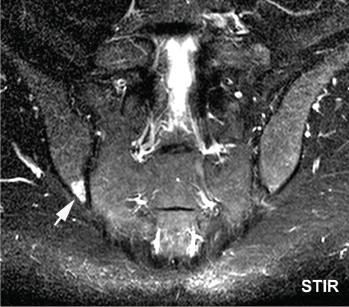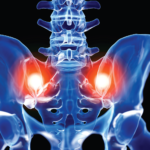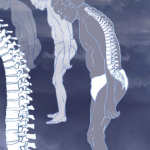
Bone marrow edema in the inferior posterior ilium, the single most affected SIJ region in athletes, is shown.
Researchers in Demark studied joints of young adult athletes to better understand the difference in bone marrow edema common in healthy people vs. what is experienced by patients with spondyloarthritis, a serious inflammatory condition of the spine and sacroiliac joints.
Early recognition of spondylo-arthritis can be tricky because it can be confused with symptoms and imaging results also seen in people with mechanical back pain and in healthy young adults, according to principal investigators Ulrich Weber, MD, King Christian 10th Hospital for Rheumatic Diseases in Graasten, Denmark, and Søren Schmidt-Olsen, MD, North Denmark Regional Hospital, Hjørring, Denmark. The study, published in Arthritis & Rheumatology, analyzed magnetic resonance imaging (MRI) scans from healthy athletes to look for normal ranges of bone marrow edema, which is characterized by cellular infiltrates and excess fluid in the bone.1
Once considered the single hallmark of sacroiliitis, bone marrow edema was found to be common in these young healthy athletes who did not have the disease, notes Dr. Weber. Therefore, physicians should use caution when interpreting MRI results to avoid mistaking possible signs of mechanical strain for spondyloarthritis, a much rarer occurrence in the general population.

Dr. Weber
“The problem is that mechanical back pain occurs as a lifetime prevalence in more than two-thirds of all people,” says Dr. Weber. “Chronic back pain is a very common disorder in industrialized countries and a leading reason for disability.”
Early axial spondyloarthritis affects young adults and is a painful inflammatory disease of the joints and spine that causes chronic low back pain. Because the sacroiliac joints are so deep in the body, the condition can be difficult to discern solely by clinical examination alone, so doctors often use MRI scans to look for sacroiliitis, inflammation of the sacroiliac joint that connects the spine to the pelvis and is the presenting feature in most patients, explains Dr. Weber.
The authors note a data-driven threshold definition of sacroiliitis is needed to reliably distinguish the lesion spectrum common to patients with early axial spondyloarthritis (axSpA) from the bone marrow edema “background noise” of MRI features that can be seen in people who are healthy or have mechanical back pain. No normal reference range for MRI scans of bone marrow edema lesions in healthy young adults exists, says Dr. Weber.

